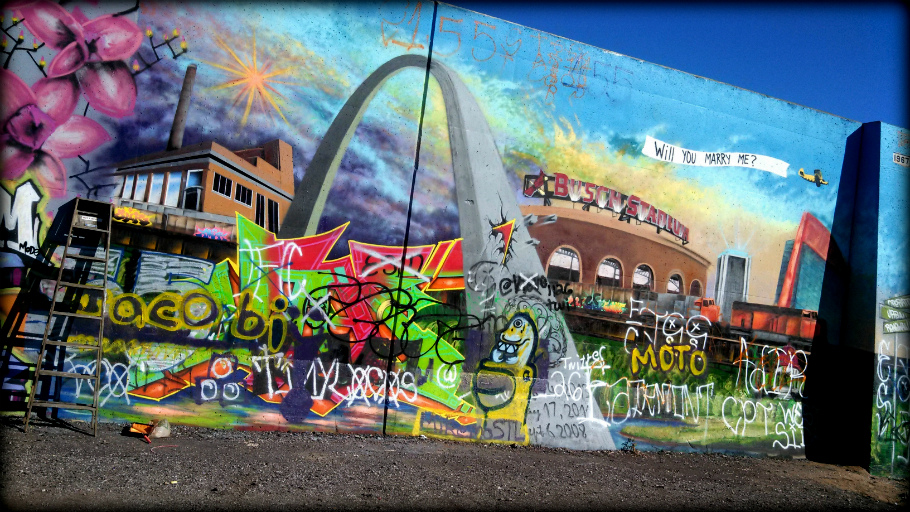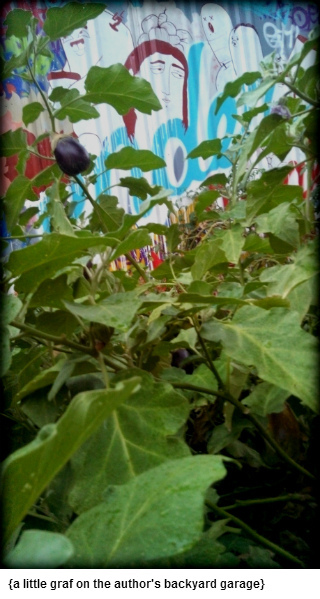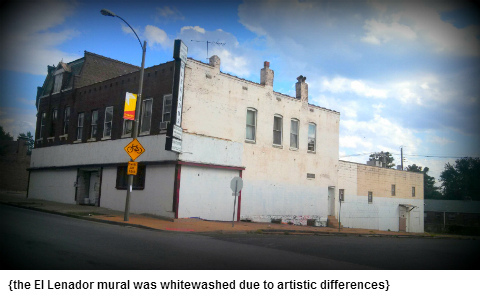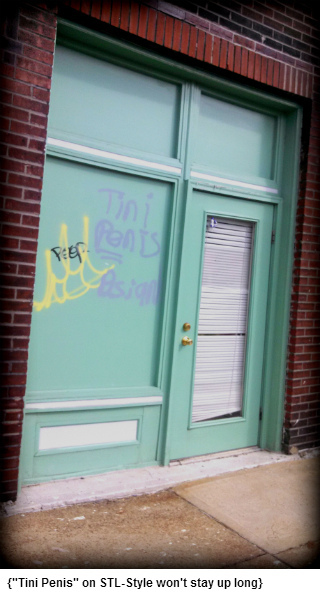
Murals can serve as a helpful fix in brightening the public space, pleasant (or even challenging) diversions from the ordinary urban aesthetic. On done on a larger scale, they could serve as a micro job generator, generating dollars for artists trained in working on big canvases. And, in some situations, they can serve as tie-ins to the more guerrilla-style, run-and-gun approach of graffiti artists, bridging two different disciplines and approaches to paint in common spaces.
Cynically, of course, one could easily serve up strawman arguments, suggesting that murals are no more than lipstick on a pig, mild balms to the deeper ills of the urban condition. A mural in a shot environment is nothing more than a goody-goody, liberal, wishful-thinking, social band-aid.
This is a hopeful corner of cyberspace, though. We like murals plenty and hope for more. Today, we’ll take a couple kicks at the can, with some Q/A action and a few more vignettes, along with some suggested reads and views. Maybe it’s not an orderly approach, but graffiti’s not an orderly topic. Here we go.
VIGNETTE #1: A GARDEN GROWS IT
Some years back, I came into the knowledge of a young man who got up by the name of Melo. In time, he began to cross over into more mainstream work, represented by a young gallery downtown called Urbis Orbis. By that point, Daniel Jefferson was working in the context of painting for clients, oftentimes showing work with his father; sometimes, his sister joined into the shows, too.

After buying a few pieces, I asked him if he wanted to put a piece on a fading wall on the back of my house. It was a dull pink, years after the initial paint job. I asked for an arch; anything else that he wanted to put on there was up to him. With a few gallons of housepaint and less than a couple hours of time, he put that arch up there, plus plenty of Asian-inspired stars, along with a few high-rise buildings. It was plenty cool at the time and I’m thankful that when I moved it exactly one structure over, so that I can still peek at the effort, anytime I like. (Thanks, too, to my neighbor’s, who’s yet to tire of the piece, himself.)
Later, I found a graffiti writer who goes by Ender. He spent the better part of a week adding color to my gray garage. The piece morphed from the original intention, a bit, at least. It grew, too, covering two sides of the garage, large and bold enough that it wasn’t just my eyes being laid on it daily, it was my neighbors’, too. Now this gets into an interesting territory, when your own desire for private property begins to mix-and-mingle with your closest neighbors’ feelings on the same. To me, a bit of graffiti’s been on my properties for most of the last 10 years. I’m used to the pieces and would seek the same if ever I moved.
To me, the pieces work. It adds to what can be a dull world of South City backyards, a twist of the usual blends of weed trees, zoysia, metal lawn chairs and sunflowers. To each their own.
A CONVERSATION WITH BRYAN WALSH OF SCREWED ARTS
Early on in this process, I came across Bryan Walsh. We were sitting about a dozen feet from one another on the patio of the Fortune Teller Bar. I’d hoped to speak to him about his work with the Screwed Arts Collective, who’d, at that point, recently finished the Screwed Cubed show at the Loop’s RAC galleries. Just as I’d looked into finding, we appeared on the street together, same time and place.
I didn’t write down all my questions, but did get down his answers, to queries about Screwed Arts, graffiti, the creative community in St. Louis generally. Let’s jump in..
We formed in 2010, the process of tightening our organization’s foundation, what we were going to do in collaborative and improvisational exhibitions. There’s a bunch of us, 11 total now. And we try not to wreak too much havoc on the spaces in which we work. And we’re all from St. Louis and based in St. Louis and take a certain pride in representing the city, as opposed to representing other city’s known for their art scenes. And we hope to be able to reveal more and represent St. Louis, interacting with plenty of people in other cities through our unique process.
Probably the highlight of our two-week process is that we are able to completely interact with the public, or open it up to the public. It’s not taking place behind closed door. While we’re installing our exhibition, we may be completely open to the sidewalk, which automatically facilitates interactions by passersby, whether they’re familiar with us, or not, whether they’re from St. Louis, or not. And that dialogue comes from spontaneous rap battles with somebody, or a teenager who might come back by with their skateboard, to see how we do images. While we’re creating our wall drawings or exhibitions, this unplanned dynamic is really special to all of us. And I would imagine that interaction is special for someone (outside the group) to experience, too.
At RAC, we worked in almost any media imaginable. Acrylics and textiles, spray paint and styrofoam, found wood and metal, what else…? Pencils and graphite and bark. It’s because of our versatility and because there are so many artists in the circle. Whatever media or tool is on-hand, somebody might use to make a mark on the wall. Everything can and has been used to n the wall, to add or subtract from what’s being presented.
Quite honestly, the opening receptions are complete whirlwinds for me, operational pinball. I’m trying to be sure to talk to almost everyone. People I know, people that I don’t known, friends and family. But the overall atmosphere of opening receptions for Screwed Arts exhibits – and our whole process – is different than most that I’ve ever seen, in town, or out. This time, there were four DJs out on the sidewalk, together, which pretty much blew everyone’s minds. DJs on the sidewalk are an automatic magnet. Plenty of people knew it was happening, that’s why they came down, to see the Screwed Arts show specifically. They were there on that Friday night and were an automatic crowd. Then you get people going to and from someplace, somewhere. It seemed that a lot of people like that came in and went inside. They were drawn to the exhibition by what the DJs were doing. These were four talented musicians, for sure.
We generally use just a few words which describe the process. More than the sale of art, it’s about collaborative and improvisational process. There were nine artists in this one and we’ve got 11, total. Typically, the range of influences and interests and practices are going to lend themselves to so many things happenings. There’re so many things happenings happening: graffiti, street art, collage, photography, text-based art. We use so many different fashions of approach that to use just one phrase to describe Screwed Arts exhibitions would be short-sighted.
I think right now, in 2013, this calendar year so far, there’s been more activity as far as what’s considered street art campaigns. I think the environment of St. Louis graffiti is in a good place, right now. Certain writers are getting up more, moving back into town. They aren’t being inhibited or interfered with by other writers, which even for me (on the outside looking in) is a sigh of relief. For a while, the last few years, or even several years, there was no progression, or whatever. Somebody would do a piece and it would automatically be gone over within a week, if not even that. There’s room for everything to grow. We have so many unoccupied buildings, so many blank walls, with graffiti and mural artists, there’s plenty of room to decorate the city more.
Overall, this region is highly conservative, whether it comes to art, or other creative endeavors or social issues.
I think with the current makeup of the Screwed Arts Collective, one member of which is female, as far as the artists involved in the past few years, it’s been a matter of who we were friends with, who makes good work and who works well with this group of artists. The fact that it’s mostly been male is purely coincidence. I mentioned earlier that we want to add more to the rest, we intend to handle a larger group of artists, but cap it before it becomes a complete mess.
I mean, as far as the dynamics as out installations, they’re generally very high stress, with long hours, loud music, plenty of alcohol involved. Caffeine, tobacco, whatever. So think that lends itself to a boisterous atmosphere artistically. At the same time, our installations are open to the public, welcoming to the public and we want friends, family, supporters, significant others hanging out for a while. It’s nice to have that energy brought by women, or other male, friends. It kind of brings things down to a chill level. Or we can amp it up if need be, to bring the energy. The timing has to be right.
I would say that in 2002, 2003, the creative environment was at a place where people can look back and… well, there were actually some really good things happening. But if you look at what was happening 10 years ago, creative individuals were moving out of town. You could almost count it back to 2001. But now, on any given Thursday, Friday or Saturday night, one typically has to choose between things one wants to go to. It’s one of the biggest problem, aside from not having enough, to have to decide which event’s going on. I know that tomorrow, there are three or four things that I’d like to hit.
I think in terms of championing interaction of folks from different socio-economic backgrounds. In other words, with St. Louis, I can only reference my own experiences. I’ve visited other cities, but this is my only living experience, except for leaving for college. My opinion is that there can always be more interaction between crowds, showing appreciation for different things. And when I end up at an event and there’s hip-hop people and punk kids and metal kids and hipsters, it’s awesome. There’s one example from the top of my head: in south California, you can have people from their 50s to their 20s, with everyone in-between. Hip-hoppers and punks raging all in one place, mashing it up together. And it’s really wherever there’s an event, there’s a project, an exhibit, wherever people are it can involved different people. In St. Louis, we need more of that happening.
I think that graffiti is so wide-ranging in practice and definition that it cannot be tackled by name. To talk about it being considered art, I’m almost always excited by the creative process. I do think there’s a lot of room for more of it to happen in St. Louis, in more places, by more people. And definitely more murals and public art. I would love to see more initiatives, more efforts to get blank walls turned into something colorful and dynamic, which would automatically encourage conversation, yeah.
Here’s a fine time-lapse video of the Screwed Cubed installation, by Jacob Eilor Berkowitz:
‘Screwed Cubed’ Installation Time Lapse from ScrewedArts on Vimeo.
VIGNETTE #2: EL LENADOR’S BLANK SPACE
In 2012, the idea to host murals on the west- and east-facing walls of Cherokee’s El Lenador became reality, with the pieces ultimately dominated by the graf writings of a variety of local names, mostly from the LD crew. There’s little doubt that the building, once a bustling German restaurant, featured some dowdy, off-color walls prior to the new additions, but the boldness and tag-style names on a huge piece of real estate canvas didn’t sit well with neighborhood residents and elected officials.

The work came at the same time that the club had become arguably the top underground music club in town, a sort of spontaneous uprising that saw acts abandoning their usual haunts for the opportunity to play music in front a huge, Alpine mural inside, with a PA system that seemed rigged to new gear on a regular basis. But with well-experienced bartenders and bookers suddenly in-place, including the omnipresent Johnny “Vegas” Moynihan, the club blew up, seemingly overnight.
The graffiti came about through third parties petitioning the building’s owner to take a chance on a huge mural. The style of the work wasn’t what was envisioned, say some. In a piece written in August of last year by Nicholas Phillips, found today at the Riverfront Times website, Moynihan’s quoted, thusly: “’We were told it would be a scenic mural,’ he says, in between drags of a cigarette. ‘But instead it looks like the side of a railroad car.’ City hall seems to agree with Moynihan’s assessment.”
The pieces were painted over. The rock’n’roll scene moved elsewhere; just down the street, both east and west, at places like Blank Space and the Livery Company. The scene had jumped up like a magical mushroom shrunk away, with if the business for El Lenador’s Mexican menu, as well. Yesterday, the walls were blank, looking very much like lost opportunities, with hints of color still peeking through.
ON THE HOLY CORNER
I’m treading on an old conceit of mine here, but to me the northeast corner of Cherokee and Compton is cultural holy ground. The multi-storefront building on that corner’s been home to the original Way Out Club, the Typo Cafe, galleries like Beverly and the Tin Ceiling’s black box theatre. For the past few years, the building’s called STL STyLe a tenant. Together with the neighboring Fort Gondo Compound for the Arts and other businesses, they’ve created a nexus of cool at the westernmost outpost of the Cherokee renaissance.
As most folks familiar with civics in St. Louis know, the tee-shirt and screenprinting business of STL STyLe is known for a local-centric approach to creating products; their lines have grown from shirts alone to a full sequence of lifestyles items including mugs, messenger bags and onesies. Jeff and Randy Vines are the proprietors, folks who don’t mind breaking the occasional egg when discussing local civics; when you think you’ll be able to predict their take on a regional issue, they’ll surprise you.
Their location is also a place that sees plenty of painted messaging on the building’s exterior. On the planned side, there’s a recent, STL-flag inspired piece that stretches across the front of their space. On the unplanned tip, there’s a brutal bit of scribbling on the Compton side of the space, including the

When the side of your building got hit with that crude graf, what was your take? A shrug? Annoyance? Something else?
Randy: We didn’t stress about it too much, as random graffiti tags are a fact of life in any city. It’s unfortunate that the tag in question has to include the word “penis” though. Oh well, it’s going to be rubbed off soon (no pun intended!).
Jeff: A shrug. Petty vandalism is pretty much a fact of life in the city, so we didn’t lose any sleep over it, and if that’s the worst thing we have to deal with, we’re cool with that. However, the tag itself is pretty pathetic. “Tini Penis”? We’re guessing it was a group of middle school kids with the artistic skills of 4-year olds.
And aren’t there plans for your doing a mural on that door?
Randy: Yep, we are commissioning Phil Jarvis to do a smaller piece on that side door, but exactly what we’ll do there is still TBD. We can only guarantee that it will be awesome.
Jeff: We hope to have the mural complete within a month.
To your remembrance, what was your take on the whole kerfuffle relating to the El Lenador graffiti mural? Too graf-like in your mind? Does the building look better/worse no than it did with the graf mural?
Randy: I think the artwork itself was totally subjective and may have appealed to certain tastes more than others, but I don’t see how anyone can argue that it was a lot cooler than a blank white wall, which is what we have now. I mean come on, talk about wasted potential. I think El Lenador should have either kept the graf mural or asked other artists to do something else there. With blank walls that place has about as much curb appeal as a methadone clinic.
Jeff: Apparently, a lot of people weren’t fans of the graffiti mural, but it definitely got everyone’s attention and opened our eyes to the possibilities that street art can do in re-energizing a scrappy streetscape. We’re not saying that the graffiti mural was any great work of art, but it was successful in transforming what was once one of the dullest facades on the street into one of the most eye-catching. Hopefully, the building owner will be open to letting artists with a real vision take another stab at it. It certainly has the potential to become another Cherokee Street landmark.
What do you think your STL flag windows add to the shop’s appeal? That was a Phil Jarvis joint, yes?
Jeff: When we looked at our storefront from across the street, we knew something was missing. We wanted something that would really draw the eye of passers-by, embodies the spirit of our shop, and would become a focal point for the street. The St. Louis flag accomplishes all those things, and Phil Jarvis is a master at bringing our concept to life.
Randy: We love our window mural! It’s very simple: just an extended version of the distinctive St. Louis flag. It’s amazing how something like a little paint can transform the aesthetic of an entire block. I’d love to see more businesses take advantage of their transom windows. It’s prime real estate.
Do you feel graffiti-styled imagery works in the context of approved public art?
Jeff: Definitely. We don’t love cities because they’re tidy, predictable and planned. We love cities precisely because they’re not. Street art adds texture and color to the urban landscape, and everybody can leave their mark in their own way. Even the “Tini Penis” posse.
Randy: Definitely. Though many may disagree, I really enjoy graffiti art. Though I don’t condone the destruction of private property, I think this kind of street art can really enhance urban streetscapes if given the opportunity. What’s the harm? The alternative would be boring, vacant walls. Let the artists have it!
What do you think of the murals in The Grove? Could a similar program work along Cherokee?
Randy: I do. The Grove has really embraced urban murals and it adds so much to the experience of Manchester Ave. I think this kind of thing can certainly work in many different neighborhoods, but I am all for originality. I’d love to see vacant storefront windows on Cherokee Street reclaimed by artists and temporary installations of all varieties. Graffiti murals would be great on lamp posts, fire hydrants and other public infrastructure (with permission), but I don’t necessarily want Cherokee to copy the exact same approach as FPSE. We can do our own thing; that would be equally cool!
Jeff: Overall, I’m glad its there, but I prefer the gritty, freestyle character of the art found along Cherokee. I think it’s great that stakeholders in The Grove are actively encouraging street art, but on the other hand, it runs the risk of losing its edge if every blank wall is designated for an elaborately planned mural. But who am I to judge — don’t listen to me!
VIGNETTE #3: BACK TO THE WALL
I’d heard tell of a big, “would you marry me”-styled piece on the flood walls downtown, the kind of upbeat, positive piece that no one could dislike. And, sure enough, it only took a bit of driving to find the work, maybe a 100 yards down from the northern start of the Paint Louis walls. (see images at top of story)
On Saturday, the piece was still hanging in there, with a plane carrying the “would you marry me?” banner, flying over representations of the Arch, Busch Stadium and, in a nice bit of attention to detail, the flood walls themselves, captured in small, meta form. Nice touch!
Less of a nice touch is the work of scribblers, who’ve added a host of nonsense at the bottom of the work, which was bought-and-paid-for by presumptive groom, I’ve been told. Next to the work, in the photo, you’ll see a ladder; over the weekend, two guys were painting on the neighboring panel, making it their own. Whether it’s at the next Paint Louis or before then, the marriage panel will eventually disappear, too, though hope the wedding takes place with enough time for photos at this wall beforehand.
Sometimes I wonder if our society deserves nice things…
FOR FURTHER READING AND VIEWING
In a perfect St. Louis, I could imagine the Screwed Arts Collective working year-round, putting up their bold work in corporate settings, as well as the streets. screwedarts.com
A couple weeks back, we pointed towards the Bushwick mural project, a New York City endeavor that’s drawn graffiti, street art and stencil artists from around the world. Here’s a nice batch of photography and back story: Bushwick Mural Project.
We’re interested in learning more about the St. Louis Mural Project via their Twitter page.

